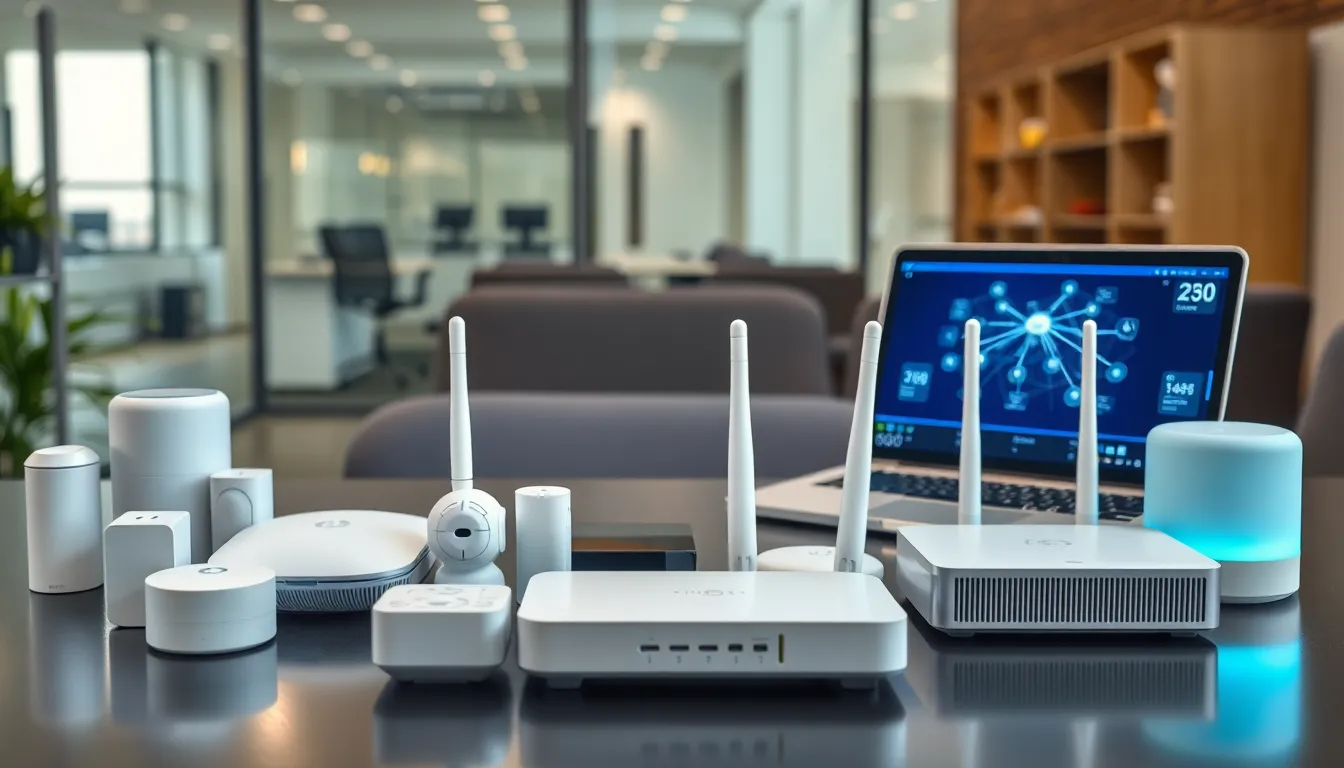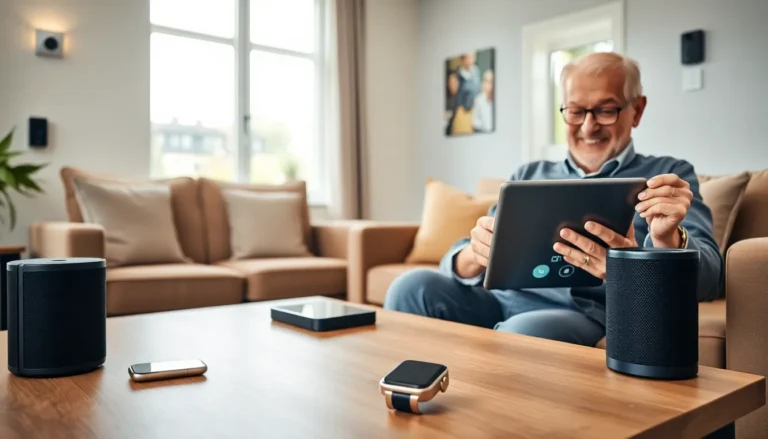The Internet of Things (IoT) is transforming how devices connect and communicate, making daily life smarter and more efficient. At the heart of this revolution lies the operating system that powers these devices, enabling seamless interactions and data exchange. As IoT technology continues to evolve, understanding the various operating systems designed specifically for this ecosystem becomes crucial.
From lightweight solutions for resource-constrained devices to robust platforms for complex applications, IoT operating systems play a vital role in determining performance, security, and scalability. With an ever-growing number of connected devices, choosing the right OS can significantly impact the success of IoT implementations. This article delves into the landscape of IoT operating systems, exploring their features, advantages, and how they shape the future of connected technology.
Table of Contents
ToggleOverview of IoT Operating Systems
IoT operating systems manage the hardware resources of IoT devices and enable seamless communication among them. They play a crucial role in device functionality, affecting performance, efficiency, and security.
Types of IoT Operating Systems
- Real-Time Operating Systems (RTOS)
RTOS provides timely processing and control, essential for applications requiring immediate responses. Examples include FreeRTOS and VxWorks, which support deterministic operations.
- Embedded Operating Systems
Embedded systems, such as Embedded Linux, focus on specific applications. They offer flexibility and customization, catering to a variety of device types.
- Linux-based Operating Systems
Linux distributions tailored for IoT, such as Yocto and OpenWrt, provide robust support for diverse hardware. Their open-source nature allows developers to modify and optimize for specific needs.
- Lightweight Operating Systems
Lightweight OS options, including Contiki and RIOT, focus on resource-constrained devices. They prioritize low power consumption and minimal memory usage, ideal for sensor networks and wearables.
Key Features of IoT Operating Systems
- Scalability
IoT OS must accommodate the increasing number of connected devices, scaling efficiently without sacrificing performance.
- Security
Security measures are vital, including data encryption and secure boot processes to protect devices from vulnerabilities.
- Interoperability
Support for multiple communication protocols ensures seamless integration across various IoT ecosystems.
- Energy Efficiency
Features promoting energy efficiency extend battery life and enhance the overall sustainability of devices.
Importance in IoT Implementations
The choice of IoT operating system directly impacts application performance, influencing factors such as response time, data processing speed, and device longevity. These systems lay the foundation for optimizing resource utilization, ensuring that devices remain effective and reliable in diverse environments. As IoT continues to advance, the capabilities of operating systems will significantly shape connected technology’s future.
Key Features of IoT Operating Systems

IoT operating systems exhibit several key features that enable effective and efficient management of connected devices. Understanding these features is essential for optimizing IoT deployments across various applications.
Resource Management
Resource management focuses on efficient utilization of hardware resources, ensuring optimal performance in constrained environments. IoT operating systems allocate CPU, memory, and storage effectively, allowing devices to perform multiple tasks concurrently. Memory management strategies, such as garbage collection and memory pooling, minimize resource wastage. Scheduling techniques prioritize tasks based on urgency, guaranteeing that time-sensitive operations receive immediate attention. Furthermore, power management features significantly extend battery life, essential for battery-operated or remote devices.
Connectivity Options
Connectivity options play a critical role in enabling communication among IoT devices. IoT operating systems support multiple communication protocols like MQTT, CoAP, and HTTP, facilitating seamless data exchange. These protocols cater to different use cases, ensuring flexibility in connecting diverse devices. Furthermore, support for both wired and wireless communication, including Wi-Fi, Zigbee, and LoRaWAN, broadens deployment possibilities. Enhanced networking features, like mesh networking, optimize device communication efficiency, expanding range and reliability in challenging environments.
Popular IoT Operating Systems
Various IoT operating systems support unique applications and hardware requirements. Here are some of the most recognized systems in the IoT landscape.
FreeRTOS
FreeRTOS is a widely adopted real-time operating system designed for microcontrollers and small embedded systems. It offers multitasking capabilities and a minimal memory footprint, making it suitable for resource-constrained devices. FreeRTOS supports a range of hardware platforms and includes features like task scheduling, inter-task communication, and synchronization mechanisms. Its open-source nature allows for customization, enabling developers to tailor its functionalities to specific use cases.
RIOT OS
RIOT OS targets IoT devices requiring a balance between performance and power efficiency. It is an open-source operating system based on Unix-like features, designed to support connectivity and interoperability. RIOT OS provides a robust networking stack that includes protocols such as IPv6, CoAP, and MQTT. It supports various hardware platforms, allowing scalability for different applications while maintaining low resource consumption. RIOT OS emphasizes modularity, enabling developers to include only necessary components, thus optimizing performance.
Zephyr Project
The Zephyr Project is an open-source platform suitable for connected low-power devices, emphasizing flexibility and scalability. It offers a rich set of libraries and device drivers, supporting multiple architectures and hardware configurations. Zephyr ensures security through comprehensive access control and authentication mechanisms. It includes support for multiple communication protocols, aiding seamless integration across diverse IoT applications. Its active community contributes to continuous improvement and innovation, making Zephyr a compelling choice for developers seeking an adaptable IoT operating system.
Comparison of IoT Operating Systems
Comparing different IoT operating systems highlights their respective strengths and weaknesses, providing insights into performance and suitability for various applications. This comparison focuses on performance analysis and practical use case scenarios.
Performance Analysis
Performance analysis of IoT operating systems involves evaluating several key metrics that impact efficiency and responsiveness.
- Latency: It measures the delay in data processing, affecting device responsiveness. Lower latency indicates quicker reactions to commands or sensory inputs.
- Throughput: It assesses data handling capacity over a specific period. Higher throughput supports efficient data transmission, essential for applications requiring constant data updates.
- Resource Utilization: It examines CPU, memory, and energy consumption. Efficient operating systems minimize resource usage, extending battery life for connected devices.
- Scalability: It denotes the system’s ability to manage an increasing number of devices or data load. Higher scalability allows smooth operation as network size expands.
A robust IoT operating system, such as FreeRTOS, may exhibit low latency and high throughput, making it optimal for real-time applications like industrial automation. In contrast, an operating system like RIOT OS might prioritize power efficiency over raw performance, making it suitable for battery-operated devices.
Use Case Scenarios
Analyzing various use case scenarios demonstrates the versatility of IoT operating systems across different environments.
- Smart Home Devices: Lightweight operating systems enable optimal performance for smart sensors and appliances, managing connectivity and processing minimal data efficiently.
- Wearable Technology: Embedded and Linux-based systems offer the necessary support for complex applications, balancing performance and power efficiency for real-time health monitoring.
- Industrial IoT: Real-Time Operating Systems (RTOS) are essential for applications requiring immediate response times, such as robotics and automated manufacturing, ensuring timely data processing and control actions.
- Agriculture: IoT operating systems that focus on scalability support large networks of sensors used in precision farming, managing extensive data while optimizing energy usage.
These scenarios illustrate how the selection of an appropriate operating system influences device functionality, operational efficiency, and overall system integration in the expansive IoT ecosystem.
Future Trends in IoT Operating Systems
Emerging trends in IoT operating systems shape the future of connected technology. These trends focus on enhancing scalability, security, interoperability, and efficiency across diverse IoT applications.
Increased Use of Edge Computing
Edge computing enables data processing closer to the source, reducing latency. IoT operating systems increasingly integrate edge computing capabilities to enhance response times for real-time applications. This shift minimizes bandwidth usage and maximizes data privacy.
Enhanced Security Protocols
Security remains a crucial concern for IoT devices. Future IoT operating systems prioritize heightened security measures, such as advanced encryption techniques and anomaly detection algorithms. These protocols aim to prevent unauthorized access and protect sensitive data across the network.
Support for Artificial Intelligence (AI) and Machine Learning (ML)
AI and ML integration into IoT operating systems allows for data-driven decision-making at the device level. Future systems will utilize AI/ML capabilities for predictive maintenance, device anomaly detection, and automated system adjustments. This functionality streamlines operations and enhances overall performance.
Improved Interoperability Standards
Interoperability becomes increasingly vital as diverse devices communicate within the IoT ecosystem. Future trends lean toward adopting common standards, such as Matter and MQTT, to ensure seamless integration across various operating systems and devices. Enhanced interoperability fosters cohesive networks, promoting functionality and user experience.
Focus on Energy Efficiency
Energy efficiency remains a priority as the number of connected devices rises. IoT operating systems evolve to incorporate power-saving features, optimizing battery life for remote devices. Future systems will implement adaptive energy management techniques to enhance sustainability in powering IoT devices.
Development of Low-Code Platforms
Low-code platforms streamline application development for IoT solutions. Future operating systems may incorporate low-code environments, enabling rapid deployment without extensive programming knowledge. This trend accelerates innovation by empowering more developers to create IoT applications.
Increased Use of Containerization
Containerization simplifies deployment and management of applications across IoT devices. Future operating systems will increasingly leverage containerization technologies, enhancing scalability and resource management. This approach simplifies updates and improves system reliability.
Emphasis on Standardization
Standardization efforts aim to unify IoT operating systems for better compatibility. Future trends will likely include initiatives focused on establishing universal protocols and frameworks to streamline device integration. Standardization enhances communication and fosters innovation across the IoT landscape.
These trends reflect the changing landscape of IoT technology, influencing how operating systems are developed and used to meet the demands of a rapidly evolving digital world.
The evolution of IoT operating systems is pivotal in shaping the future of connected devices. As technology advances the need for efficient resource management security and interoperability becomes increasingly critical. Developers must carefully consider the specific requirements of their applications when selecting an operating system to ensure optimal performance and reliability.
With the rise of edge computing and AI integration the landscape of IoT operating systems will continue to evolve. Embracing these trends will enable developers to create innovative solutions that enhance device functionality and user experience. The journey of IoT is just beginning and the right operating system can make all the difference in harnessing its full potential.





